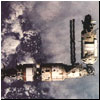|
|
|
|
HIGHLIGHTS
OF MIR'S 15 SPECTACULAR YEARS
|
|||||||
|
1986: Tale of two space stations The core module of the Mir space station, which means "peace" and "world" in Russian, starts its orbital journey on February 20, 1986. The station's first crew, Leonid Kizim and Vladimir Soloviev, literally shuttle their Soyuz T-15 spacecraft to Salyut-7, the Mir's predecessor, work there and then return back to Mir. |
||||||||
|
The Kvant-1 module, a first addition to the station, joined Mir in April after a dramatic docking saga. When the new module fails to achieve a complete docking with Mir, the station's residents Yuri Romanenko and Alexander Laveikin walk outside the station to check for problems. They found and successfully removed and bag of trash stuck in the docking port, which was prevented the docking. In July Syrian "guest" cosmonaut, Mohammed Faris, spends a week onboard Mir. |
||||||||
|
1988: Buran - an unfulfilled promise Bulgarian Alexander Alexandrov and Afghan Abdul Ahad Mohmand visit Mir for a week as "guest" cosmonauts during 1988. In the meantime, below on Earth, in Baikonur, the thousands of workers, soldiers and technicians are finishing a monumental task of preparing the Buran reusable spacecraft for the first test run into orbit. The second test flight of the Buran, if it ever happened, would involve docking with Mir. In December, a French veteran astronaut Jean-Loup Chretien spends a month on Mir and becomes the first non-US, non-Russian space traveler to venture outside the spacecraft. |
||||||||
 |
After a four-month break in manned operations due to the damage of the Soyuz spacecraft in Baikonur, the Mir is inhabited again in September. In December, Mir is "upgraded and improved" with a 19-ton Kvant-2 module, which among other things brings a large airlock to the station and a maneuvering unit for spacewalking cosmonauts. |
|||||||
|
During two of their five spacewalks, cosmonauts Alexander Viktorenko and Alexander Serebrov flew a backpack-style maneuvering unit, which allows "untethered" floating in space. Due to Mir's inability to maneuver to pick up the cosmonaut in case his "backpack" fails, both crewmembers remain tethered during the tests. They would need no tether in the presense of the Buran. In December, Tokyo Broadcasting System (TBS) journalist Toyohiro Akiyama reports on Mir operations "from the scene" during his visit to the station. |
||||||||
|
1991: Flying into the new world As the Soviet Union collapses underneath, Mir's cosmonaut Sergei Krikalev agrees to stay for a second term onboard Mir to make possible a politically important visit of Toktar Aubakirov, a cosmonaut from newly independent Kazakhstan. However, the US media, portray Krikalev as a stranded cosmonaut, unable to return home due to the collapse of the Soviet Union. On the same mission which brought Aubakirov, an Austrian researcher Franz Viehboeck visits Mir. In May, a British passenger, Helen Sharman, visits Mir on a privately financed mission. |
||||||||
|
In March, Klaus Dietrich Flade, a researcher from recently unified Germany visits Mir. He is not the first German to fly to the Russian space station though. 14 years before, a cosmonaut from East Germany had spent a week onboard Salyut-6. In August, the French astronaut Michel Tognini visited Mir. During three spacewalks in September, cosmonauts Anatoly Soloviev and Sergei Avdeev "crowned" recently built Sofora truss with a propulsion unit delivered onboard Progress cargo ship. |
||||||||
|
On February 4, the Progress M-15 cargo ship separated from the Mir space station and at the distance 230 meters deployed a giant foil-thin screen. It was known as Znamya-2 or "banner" experiment. The Russian creators of this fantastic technology claimed it could be used in the future for illuminating starving for light cities beyond the Arctic Circle. Many observers also said it has been the first test of the so-called solar sail propulsion. Numerous observers on Earth see Znamya, even after it was discarded from the Progress. |
||||||||
|
On January 8, the Soyuz TM-18 spacecraft blasted off toward Mir with a crew of three including medical specialist Valery Polyakov. As his crewmates returned to Earth in July, Polyakov remained onboard Mir until March of 1995, which is long enough to make a trip to Mars. He established an absolute record for human presence in space on a single mission - 438 days. In October, Soyuz TM-20 delivered to Mir a three-member crew including Elena Kondakova, who spends 169 days in space (a record for a female) and German-born researcher from European Space Agency Ulf Merbold, who in November 1983 participated in the first Spacelab mission onboard Shuttle Columbia. |
||||||||
|
NASA astronauts become long-term guests onboard Mir, with the launch of Norman Thagard in March onboard Soyuz spacecraft from Baikonur. In anticipation of joint US-American operations on Mir, the station is reconfigured and grows by one module. In July, the US Space Shuttle docks to Mir for the first time. It picks up Norm Thagard and two Russian cosmonauts for a ride home. In September, the Soyuz TM-22 delivers a crew of three to Mir, including European astronaut Thomas Raiter, who spent 179 days in space. |
||||||||
|
A decade long construction of Mir concludes with the arrival of the Priroda module to the station on April 26. With its successful docking, no "vacancies" remains on the core module's docking ports. On March 24, the US astronaut Shannon Lucid boards Mir for what turned out to be a 188-day mission, a longest space flight for a NASA astronaut. In September, John Blaha replaces Lucid as NASA representative onboard Mir, completing a 118-day mission. |
||||||||
 |
1997: Houston, we have a problem In the midst of the Russian-American joint operations on Mir, the station went through the worst year in its history marked by a fire and a collision with a cargo ship. These accidents soured forever the relationship between NASA and Russian Space Agency, while US media made Mir a favorite subject for attacks and ridicule. Despite problems, during the year, NASA astronauts Jerry Linenger and Mike Foale log 122 and 134 days in space respectively. |
|||||||
|
1998: The beginning of the end Two last missions of American astronauts David Wolf and Andy Thomas to Mir turn into a public relations nightmare for NASA. The agency Director Dan Goldin had had to "certify" Mir as "safe," before he authorized Wolf's 119-day mission to the station. As Andy Thomas had returned from Mir after a 130-day mission, the last US visit to Mir, NASA pressed Russian government to deorbit the station as soon as possible. On November 20, the Proton rocket boosted into orbit the Zarya space tug, the first element of the International Space Station, opening a new page in space exploration. Yet, RKK Energia, the Mir operator, continues struggle to keep the aging station alive. |
||||||||
|
With a flow of US cash evaporated, the future of the Mir space station remained in limbo. When all efforts to raise private funds for future missions prove futile, RKK Energia does not send a replacement crew to the 27th expedition, which lands on August 28. Yet, during their expedition to Mir, cosmonauts Viktor Afanasiev and Sergei Avdeev perform perhaps the most spectacular experiment onboard Mir, deploying a giant umbrella-like antenna outside the station. The French cosmonaut Jahn Pierre Haignere accompanied his Russian colleagues during 188-day mission, while Slovakian researcher Ivan Bella spent a week on Mir in February. |
||||||||
|
2000: Honey, I booked a ride to Mir! At the beginning of the year, a group of US businessmen announces a creation of MirCorp with the goal of "privatizing" Mir operations. MirCorp is able to finance a single 72-day mission of Alexander Kaleri and Sergei Zaletin to Mir, while trying to sell "joy rides" to the station. Although a few potential "customers" make headlines during the year, their contributions is not enough to keep the aging station operational. As the first Russian-American crew prepares to take residence onboard the International Space Station in October, RKK Energia decides to terminate Mir's flight. Unless an emergency "burial" crew is needed in 2001, Kaleri and Zaletin, who landed on June 16, turned out be the last people, who lived on Mir. |
||||||||
|
RKK Energia waits with the Mir deorbiting, until the station celebrates its 15th anniversary in space on February 20, 2001. The deorbiting maneuver is planned for the end of February or beginning of March 2001. |
||||||||